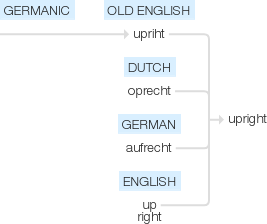Upright
Old English upriht, of Germanic origin; related to Dutch oprecht and German aufrecht (see up, right).
wiktionary
From Middle English upright, uppryght, upriht, from Old English upriht(“upright; erect”), from Proto-Germanic *upprehtaz, equivalent to up- + right. Cognate with Saterland Frisian apgjucht(“upright”), West Frisian oprjocht(“upright”), Dutch oprecht(“upright”), German Low German uprecht(“upright”), German aufrecht(“upright”), Swedish upprätt(“upright”), Icelandic upprétt(“upright”).
etymonline
upright (adj.)
Old English upriht "erect, face-upward;" see up (adv.) + right (adj.1). Similar compounds are found in other Germanic languages (Old Frisian upriucht, Middle Dutch oprecht, Old High German ufreht, German aufrecht, Old Norse uprettr). Figurative sense of "good, honest, adhering to rectitude" is first attested 1520s.
As an adverb, Old English uprihte. As a noun, 1560s in the sense "a vertical front;" c. 1700 as "a vertical timber in framing;" 1742 in the sense "something standing erect." Meaning "an upright piano" is from 1860.
THREE-PENNY UPRIGHT. A retailer of love, who, for the sum mentioned, dispenses her favours standing against a wall. ["Dictionary of the Vulgar Tongue," 1811]
The bent-over rear-entry posture they are talking about, of course, is kubda, the three-obol position at the bottom-end of a prostitute's price-range. [James N. Davidson, "Courtesans and Fishcakes: The Consuming Passions of Classical Athens," 1997]
